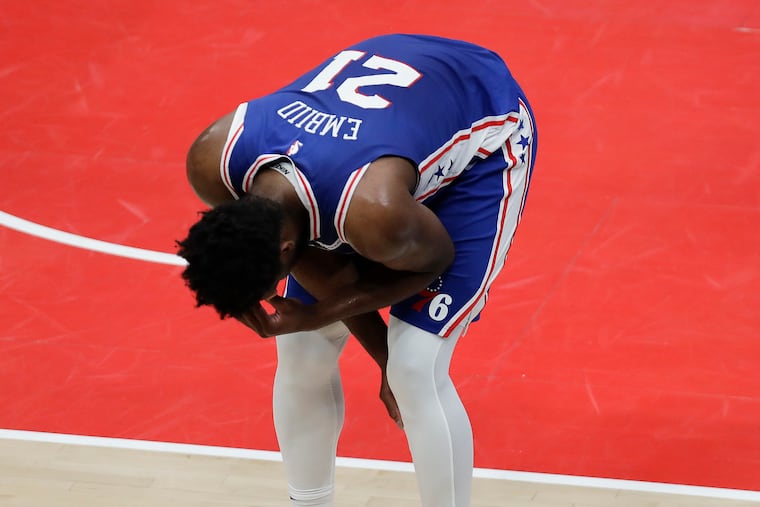Joel Embiid has a meniscus tear. Here’s what that means.
A key question, a doctor says, is whether the tear is causing instability.

The Sixers announced Wednesday that Joel Embiid has a small, lateral meniscus tear in his right knee. The team said he is considered “day to day” for future play and will be treated with physical therapy, not surgery.
Embiid had season-ending surgery to repair a meniscus tear in his left knee during the 2016-17 campaign.
» READ MORE: Here’s why Joel Embiid's size puts him at greater risk of injury
What is a meniscus?
The menisci are two thin, C-shaped pieces of fibrocartilage that act as “shock absorbers” between your thighbone and shinbone where those bones join at the knee, according to the American Academy of Orthopedic Surgeons. The menisci are important for knee stability.
The medial meniscus is on the inside of the knee and the lateral meniscus — the one Embiid tore — is on the outside. John Vasudevan, a physical medicine and rehabilitation specialist with Penn Sports Medicine, said tears to the lateral meniscus are less common and tend to be less severe.
How do you know when you have a torn meniscus?
These injuries are often caused by sudden twisting movements, especially among athletes.
The most common symptoms are pain, stiffness, swelling, locking of the knee joint and reduced range of motion. Some people feel a “pop” when the injury occurs. Swelling and stiffness may worsen a couple of days after the injury.
What is the treatment?
While some injuries require surgery, others can heal on their own. Typically, these are in the outer third of the meniscus, which gets a rich blood supply. Surgery is still a possibility if natural healing doesn’t go well, Vasudevan said.
Doctors often recommend the RICE protocol. That stands for rest, ice, compression, and elevation. Patients are advised to stay off the leg, use ice packs frequently, wear an elastic compression bandage, and rest with the leg higher than the heart to reduce swelling.
Doctors could also suggest anti-inflammatory drugs like ibuprofen or injections of corticosteroids. Because “time is of the essence,” doctors might try steroids faster in Embiid’s case, Vasudevan said.
What would physical therapy entail?
Vasudevan said physical therapists will want to reduce pain and swelling while maintaining range of motion, strength and agility. It will be important to strengthen all the muscles and joints in the leg to reduce pressure on the damaged knee. A weak ankle, for example, can “transmit undue force to the knee.”
How long before Embiid can play?
This is, of course, the most important question and the hardest one to answer. Vasudevan hasn’t seen Embiid’s medical reports, so he can only guess. “One of the challenges in sports medicine,” he said, “is we always have to weigh what the person can do and what they should do.” The key factor, he said, is whether the injury is causing knee instability. Embiid might be able to play safely through some pain, but instability is more dangerous. Either might affect his performance. The doctor said the first three weeks of recovery are the most challenging.
It would likely take six to 12 weeks for most non-athletes to be ready to return to running or other sports after this type of meniscus tear, he said. “It’s hard to rush nature, truly,” he said.
Embiid might be able to return to play after this series if he played for short, carefully chosen periods. A knee brace could help. “He may be out for a game or two and then play limited minutes when they really need his skill set,” Vasudevan said.
The long-term prognosis is good. ‘”Knowing how important he is to the Sixers and really to the whole league, they’re going to be very cautious with this. My guess is he’ll be fine for the fall.”
Even if Embiid plays again this season, he likely won’t be in top form, so his teammates will have to step up, Vasudevan said. “To have Joel Embiid carry this team on his back, now is not the time.”